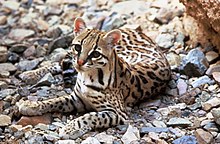The ocelot is similar in appearance to a domestic cat. Its fur resembles that of a clouded leopard or jaguar and was once regarded as particularly valuable. As a result, hundreds of thousands of ocelots were once killed for their fur. The feline was classified a "vulnerable" endangered species from 1972 until 1996, and is now rated "least concern" by the 2008 IUCN Red List.

Etymology
The name ocelot comes from the Nahuatl word ōcēlōtl (pronounced /oːˈseːloːt͡ɬ/), which usually refers to the jaguar (Panthera onca) rather than the ocelot.[6][7][8]Taxonomy

The ocelot's genus Leopardus consists of nine species similar to the ocelot, such as Geoffroy's cat and the margay, which are also endemic to South and Central America. All of the cats in Leopardus are spotted, lithe, and small, with the ocelot being the biggest.
Subspecies
The following are the currently recognized subspecies of ocelot:[1]
- Leopardus pardalis pardalis, Amazon Rainforest
- Leopardus pardalis aequatorialis, northern Andes and Central America
- Leopardus pardalis albescens, eastern Mexico, southern Texas
- Leopardus pardalis melanurus, Venezuela, Guyana, Trinidad
- Leopardus pardalis mitis, Argentina, Paraguay
- Leopardus pardalis nelsoni, southwestern Mexico
- Leopardus pardalis pseudopardalis, Colombia
- Leopardus pardalis puseaus, Ecuador
- Leopardus pardalis sonoriensis, northwestern Mexico, southern Arizona
- Leopardus pardalis steinbachi, Bolivia
Physical characteristics
The ocelot ranges from 68 to 100 centimetres (27 to 39 in) in length, plus 26 to 45 centimeters (10 to 18 in) in tail length, and typically weighs 8 to 18 kilograms (18 to 40 lb), although much larger individuals have occasionally been recorded,[9][10][11] making it the largest of the generally dainty Leopardus wild cat genus. It has sleek, smooth fur, rounded ears and relatively large front paws. While similar in appearance to the oncilla and margay, which inhabit the same region, the ocelot is larger.The coat pattern of ocelots can vary, being anything from cream to reddish-brown in color, or sometimes grayish, and marked with black rosettes. In many individuals, some of the spots, especially on the back, blend together to form irregular curved stripes or bands. The fur is short, and paler than the rest of the coat beneath. There are also single white spots, called ocelli, on the backs of the ears. Two black stripes line both sides of the face, and the long tail is banded by black.
Behavior
The ocelot is mostly nocturnal and very territorial. It will fight fiercely, sometimes to the death, in territorial disputes. In addition, the cat marks its territory with urine. Like most felines, it is solitary, usually meeting only to mate. However, during the day it rests in trees or other dense foliage, and will occasionally share its spot with another ocelot of the same sex. Males occupy territories of 3.5 to 46 square kilometers (1.4 to 17.8 sq mi), while females occupy smaller, non-overlapping territories of 0.8 to 15 square kilometers (0.31 to 5.79 sq mi). Territories are marked by urine spraying and by leaving feces in prominent locations, sometimes favoring particular latrine sites.[10]Ocelots hunt over a range of 18 km2 (6.9 sq mi), taking mostly small animals, including mammals, lizards, turtles, and frogs, crabs, birds, and fish.[12] Almost all of the prey that the ocelot hunts is far smaller than itself, with rodents, rabbits, and opossums forming the largest part of the diet.[10] Studies suggest that it follows and finds prey via odor trails, but the ocelot also has very good vision, including night vision.
Reproduction and life cycle
Ocelots typically breed only once every other year, although the female may mate again shortly after losing a litter. Mating can occur at any time of year, and estrus lasts from seven to ten days. After mating, the female will find a den in a cave in a rocky bluff, a hollow tree, or a dense (preferably thorny) thicket. Gestation lasts 79 to 82 days, and usually results in the birth of only a single kitten, with its eyes closed and a thin covering of hair. Litters of two or three kittens also occur, but are less common. The small litter size and relative infrequency of breeding make the ocelot particularly vulnerable to population loss.[10]Compared with other small cats, ocelot kittens grow quite slowly. They weigh around 250 grams (8.8 oz) at birth, and do not open their eyes for 15 to 18 days. They begin to leave the den at three months, but remain with their mother for up to two years, before dispersing to establish their own territory. Ocelots live for up to 20 years in captivity.[10]
Distribution and habitat
The ocelot is distributed extensively over South America (including the islands of Margarita and Trinidad), Central America, and Mexico with a small population in southern Texas.[1][3][13][14] Countries in this range are: Argentina, Belize, Bolivia, Brazil, Colombia, Costa Rica, Ecuador, El Salvador, Guatemala, Guyana, Honduras, Mexico, Nicaragua, Panama, Paraguay, Peru, Suriname, Trinidad and Tobago, United States and Venezuela. The cat is likely extinct in Uruguay.[2]
The remnant U.S. ocelot population in south Texas has declined from 80-120 individuals in 1995 to less than 50 in recent years, with about half of ocelot deaths resulting from automobile accidents.[18][19] Most surviving Texas ocelots are in the shrublands remaining at or near the Laguna Atascosa National Wildlife Refuge near Brownsville, where only 30-35 animals remain.[20]
In Trinidad, habitat fragmentation, as well as direct exploitation via illegal poaching are major threats to the survival of the remnant populations of ocelots on the island. No empirical studies have been conducted to reliably estimate population status on the island. Historical records indicate that the species once existed on the island of Tobago, but it has long been extirpated there.[citation needed]
Ocelots only inhabit areas with relatively dense vegetation cover, although they may occasionally hunt in more open areas at night. They are found in tropical forest, thorn forest, mangrove swamps and savanna, at elevations ranging up to 1,200 meters (3,900 ft).[10]
As pets

Musician Gram Parsons kept an ocelot as a pet in the back yard swimming pool area of his family's Winter Haven, Florida, home, during his teens, in the mid-1960s.[23]
The Moche people of ancient Peru worshipped animals and often depicted the ocelot in their art.[24]



No comments:
Post a Comment
Note: Only a member of this blog may post a comment.